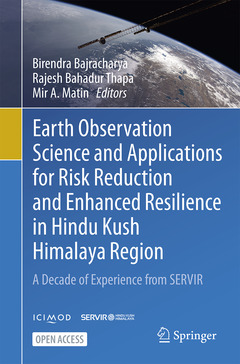Description
Earth Observation Science and Applications for Risk Reduction and Enhanced Resilience in Hindu Kush Himalaya Region, 1st ed. 2021
A Decade of Experience from SERVIR
Coordinators: Bajracharya Birendra, Thapa Rajesh Bahadur, Matin Mir A.
Language: English
Subjects for Earth Observation Science and Applications for Risk...:
375 p. · 15.5x23.5 cm · Paperback
Description
/li>Contents
/li>Biography
/li>Comment
/li>
This open access book is a consolidation of lessons learnt and experiences gathered from our efforts to utilise Earth observation (EO) science and applications to address environmental challenges in the Hindu Kush Himalayan region. It includes a complete package of knowledge on service life cycles including multi-disciplinary topics and practically tested applications for the HKH. It comprises 19 chapters drawing from a decade?s worth of experience gleaned over the course of our implementation of SERVIR-HKH ? a joint initiative of NASA, USAID, and ICIMOD ? to build capacity on using EO and geospatial technology for effective decision making in the region.
The book highlights SERVIR?s approaches to the design and delivery of information services ? in agriculture and food security; land cover and land use change, and ecosystems; water resources and hydro-climatic disasters; and weather and climate services. It also touches upon multidisciplinary topics such as service planning; gender integration; user engagement; capacity building; communication; and monitoring, evaluation, and learning.We hope that this book will be a good reference document for professionals and practitioners working in remote sensing, geographic information systems, regional and spatial sciences, climate change, ecosystems, and environmental analysis. Furthermore, we are hopeful that policymakers, academics, and other informed audiences working in sustainable development and evaluation ? beyond the wider SERVIR network and well as within it ? will greatly benefit from what we share here on our applications, case studies, and documentation across cross-cutting topics.
Chapter 1. Introduction and rationale.- Chapter 2. SERVIR: A global network of environmental management with Earth observation and geospatial technology.- PART 1. APPROACH FOR SUSTAINABLE IMPACTS.- Chapter 3. Understanding the gaps, needs and priorities of National agencies in the Hindu Kush Himalayan region to use Earth observation and Geospatial tools for decision making.- Chapter 4. Service planning framework.- PART 2. DATA SCIENCE AND SERVICES FOR IMPROVING AGRICULTURE, FOOD SECURITY AND RESILIENCE.- Chapter 5. Getting prepared for droughts in South Asia.- Chapter 6. Mapping crops for better national production estimates in Afghanistan and Nepal.- Chapter 7. Understanding agriculture land use practices to support food security planning and policies in Pakistan.- Chapter 8. Mapping and monitoring food insecurity in Nepal.- PART 3. UNDERSTANDING LAND COVER DYNAMICS AND ECOSYSTEM SERVICES.- Chapter 9. Regional land cover monitoring system .- Chapter 10. Supporting scientific forest management in Nepal.- Chapter 11. Forest Fire Detection and Monitoring.- PART 4 – WEATHER AND CLIMATE SERVICES FOR WATER AND HYDRO-CLIMATIC DISASTERS.- Chapter 12. Enhancing flood early warning in the Hindu Kush Himalayan Region.- Chapter 13. Rapid flood mapping using multi-temporal SAR images: an example from the Bangladesh.- Chapter 14. Glacier, Glacial Lakes and its Change Assessments in Afghanistan.- Chapter 15. High impact weather assessment tool.- PART 5 – ENABLING ENVIRONMENT.- Chapter 16. Systems for information management and dissemination to the users.- Chapter 17. Enabling capacity of individuals and institutions in geospatial information technology and Earth observation applications.- Chapter 18. Gender perspectives in Earth observation information technology and applications.- Chapter 19. Communicating science for decision making (Utsav).- Chapter 20. Strengthening User Engagement.- Chapter 21. Earth observation information for lasting impact: planning, monitoring, evaluation and learning.- PART 7 - LESSONS AND FUTURE PERSPECTIVES.- Chapter 22. Lessons and future perspectives.
Rajesh Bahadur Thapa is Remote Sensing and Geoinformation Specialist at ICIMOD. His work focuses on radar applications to monitor and assess terrestrial environments, and capacity building on Earth observation and geoinformation technologies in the region.
Mir Matin is Theme Leader for the Geospatial Solutions at ICIMOD. He provides scientific leadership in building and promoting innovative and user-oriented geospatial applications to support improved resilience and livelihoods in the region.
Earth observation science and applications for improving environmental decision making in transboundary landscape
A collection of multi-disciplinary topics with practically tested applications for Hindu Kush Himalayan region
A complete package of knowledge on project cycle including service area planning, stakeholder consultation, user engagement, capacity building, monitoring and evaluation, gender integration, and communications.




